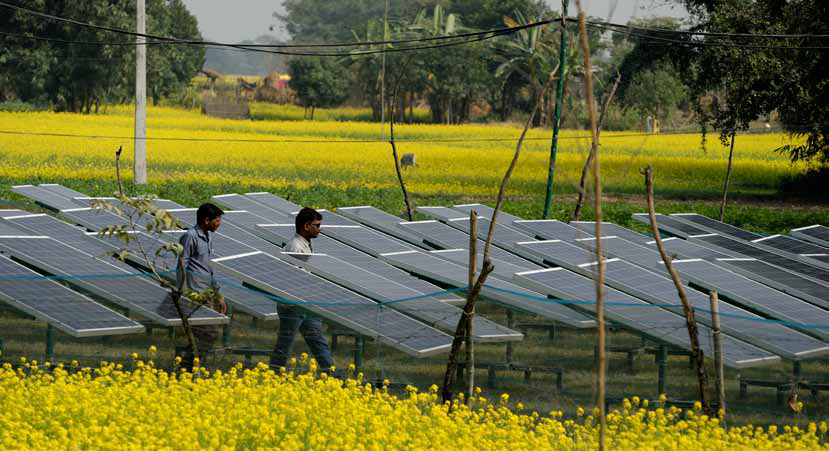The Prime Minister of India has been saying that electricity will be brought to all villages by 2018 with power available 24×7 to all households by the year 2019. The task, however, appears easier said than done as currently, more than 250 million people are without electricity access and probably an equal number do not have a reliable supply. With an increase in the number of households every year by around 3 million households, the problem gets compounded. Some of the recent developments, such as notification of tariff policy, launch of Ujjwal Discom Assurance Yojana (UDAY) scheme to address the chronic issues of the electricity distribution sector, launch of UJALA i.e. the domestic efficient lighting programme etc., do, however, indicate that central and state governments are working collectively to ensure power for all in India.
One area worth discussing in this discourse is the government’s recognition of micro-grids with recent developments on the policy front. The first was an explicit reference to microgrids within the national tariff policy notified in January 2016. This policy recognizes the importance of ensuring last-mile connectivity by creating an enabling condition for investment in microgrids. At the state level, Uttar Pradesh, where electricity access availability and reliability are major issues, took the lead and announced its state micro-grid policy to provide a conducive investment climate to stimulate private participation. The Uttar Pradesh Electricity Regulatory Commission followed it up with the announcement of regulations for operationalizing the policy for system capacity up to 500 KWp. Another important development was the release of the draft national policy on renewable energy based mini/micro-grids by the Ministry of New and Renewable Energy (MNRE) in June 2016. This policy aims to mainstream renewable energy based micro-grids, through building a supportive ecosystem to encourage rural energy service providers and investors into the micro-grid space, for enhancing access to affordable energy services and improving the local economy.
All the above are undoubtedly laudable moves. However, there are many grey areas that need to be addressed before we can derive full benefits of these policies and regulations to scale-up the implementation of microgrids in India. Some of these are discussed in this article.
The first issue is non-clarity in the service areas for main grids and microgrids. Before we proceed further, it would be important to throw light on where the unelectrified 50 million rural households are located, as this will bring clarity on how such households could be electrified –through grid expansion, microgrids or through stand-alone systems. In order to get an appropriate answer, it would be necessary at the foremost to categorize these unelectrified households. They could be classified into three main categories, which are: (1) those residing in remote inaccessible villages where extending the main grid may be techno-economically infeasible; (2) unelectrified households in villages where the electric poles and grid exist; and (3) those residing in unelectrified hamlets i.e. small habitations in periphery of grid connected villages.
As per Government of India statistics, there are around 11,000 unelectrified villages (as on April 30, 2016). Of these, around 4000 belong to the first category and are being electrified through micro-grids under the government programme and the balance by extending the grid. Rough estimates indicate that, of
the total unelectrified population, less than 5 million are in the villages where microgrids are being set up by the government. The other 245 million probably are in villages that already have the main grid and/or in the unelectrified hamlets of electrified villages.
The unconnected households in electrified villages i.e. the second category of villages, where investment towards grid infrastructure has already been made, could probably be connected through lending the connection cost, where electricity distribution companies can tie up with finance institution or banks (now that Prime Minister Jan Dhan scheme has facilitated bank accounts for all rural households). The local banks can finance the connection cost (including towards household wiring and energy meter) and the money can be recovered by the Discom through monthly electricity bills. One may argue that with chronic power shortages in many areas, electricity supply from micro-grids could meet the demand. While some developers are taking the risks and setting up micro-grids in such areas, the sector is not scaling-up as developers are always in uncertainty. Any improvement of power supply in the main grid will tempt the consumers to shift from costly unregulated electricity from micro-grids to regulated grid electricity but with much lower tariff. With coal-fired plants in India running at an average 68% of their capacity and UJALA programme’s aim to replace energy-intensive appliances with more efficient designs, it is clear that currently there is no shortage of energy. The saved energy due to energy efficiency measures will further release additional energy in the grid. The critical challenge lies with payment by rural consumers for the electricity and efficiency of Discoms to manage its affairs, which the Government of India is attempting to address through the UDAY scheme. However, in the short-term, many households are buying solar home systems or other individual systems and thus there is further scope of market development in the solar home system sector primarily focussing on this category of households.
This leaves the third category of unelectrified households. While grid is being extended to cover such households, it also needs to be recognized that covering all unelectrified hamlets may not be without its share of problems. As installation of transmission and distribution infrastructure in these habitations and for the supply of energy involves substantial costs, unless commensurate benefits are forthcoming with households taking the connection, the problem will only get compounded. On the other hand, distributed generation option, using locally available renewable energy resources, are a much better alternative to electrify these hamlets. However, lack of information on whether the main grid will be extended to a hamlet and when, hampers private participation even if strong business models are developed and incentivized by policies.
Second, the tariff policy mentions that investment involved in setting up micro-grids is substantial and one of the investment risks is the main grid reaching the area before the investment is recovered. It further adds that to mitigate such risks and incentivize investment, an appropriate regulatory framework is required to ensure compulsory purchase of power into the grid from such micro-grids. While one waits for the framework to be notified, it is important to take note that currently, there is no parity between micro-grid and grid-based tariff, which puts the micro-grids at an obvious disadvantageous position.
The state policy for Uttar Pradesh is an apt example. The policy allows projects to be established by the private sector with 10 years of mandatory O&M, with the government providing 30% subsidy. However, the monthly tariff is capped at INR 60 to INR 120, depending on load when subsidy will be availed. Experience from the few existing private sector projects, operating in the state (who have availed subsidy or received grant funding from donors), indicates that their tariffs range between INR 120 and INR 200 for basic power supply. Discussion with few developers indicates that any tariff below the existing price will make their operation unviable. The MNRE micro-grid policy also binds the developer to set tariff with a concurrence of state government authority or the regulator if any subsidy is availed or in case of connection to the grid. Alternatively, both the policies provide for installing micro-grids without subsidy and charge tariff based on mutual consent with the consumers. However, while the MNRE policy allows 16% return on equity investment for setting the tariff, the UP policy is ambiguous on this matter. Further, without any subsidy, the tariff will also increase thus making the electricity supply out of reach of the underprivileged households.
A point worth highlighting here is that often end-users of renewable energy-based systems compare the cost of electricity from a micro-grid to that of the main grid and are therefore prone to believe that expensive power is being sold to them. Further, at present, the renewable energy systems operators do not get the benefit of tariff cross-subsidization, which is available to Discoms. The sector will be ready to scale up rapidly once improved services can be offered at or below the monthly expenditure incurred on kerosene or similar to the price of regulated tariffs.
To bring parity and at the same time ensure the viability of micro-grids, the regulators could think of creating a universal service obligation fund, through a suitable mechanism, such as using cross-subsidy or levying a cess on conventional electricity and/or deploying savings from the reduction in kerosene subsidy. Using the Aadhar (unique identification) platform, this amount can be used to provide a direct subsidy to underprivileged consumers. However, any subsidy from the government to the private sector should be results-based and probably linked to the equity capital contributed by the micro-grid operators and the finance they can raise from the banks and financial institutions.
Main Grid Future Interoperability
Third, the central and UP state policies indicate that microgrids can start feeding power to the main grid when the grid reaches such villages. However, there is lack of clarity related to their inter-connectedness and fate of the micro-grid infrastructure when the grid reaches such villages. This is very important in the context of the decentralised distributed generation (DDG) guidelines under the national rural electrification programme, which specifies that infrastructure should be grid compatible so that the investment will continue to be useful once a village is connected to the grid. For example, while, most developers design the distribution network adequately to withstand the connected demand averaging 100 watts per household, the national rural electrification programme by the Ministry of Power provisions minimum 250 watts per household. The 2013 regulations of the Central Electricity Authority (offering technical standards for connectivity of the distributed generation resources) also do not provide clarity on the interconnection of one or multiple micro-grids with the local grid network. The key regulatory issue is the development of standards that will allow for a cost-effective interconnection solution without jeopardizing the safety and reliability of the power systems. Further, though the policy specifies that the micro-grid developer can start feeding the generated power to the grid at feed-in tariff (FiT), it is unclear whether the developer can continue to serve locally, using locally generated distributed power, and at the same time uptake electricity from the grid as it reaches there and demand also increases over time.
Tariff Policy for Microgrids in India
Fourth, it is not clear from the tariff policy how regulators will set the FiT. The FiT for microgrids should not be same as FiT for larger capacity grid-connected systems, which has the inherent advantage of ‘economies of scale’, although they suffer from a higher technical loss when the generated power is to be taken to remote villages. The FiT should ideally be set considering the realistic operation and maintenance cost of the small systems.
Last but not the least is access to finance at the right terms and conditions which are critical for scaling-up mini/micro-grids. While part-subsidy from government exists under some schemes, generation of the remaining capital at lower cost and/or without any collateral is difficult because of the high perceived risks of the investment in micro-grids. Hence, in the absence of a risk guarantee mechanisms, financial institutions are generally reluctant to lend. In addition, smaller capacity of projects makes it difficult to attract equity finance due to perceived challenges of scalability. Thus, unless Government includes the sector under priority sector infrastructure provisioning it would be challenging to procure low-cost and long-term finance for micro-grids and could frustrate the very objective of ensuring last mile connectivity.
While the recent developments in the micro-grids space are positive, what is needed is to ensure that the ambiguities are addressed through consultations with all stakeholders for ease of doing business for micro-grid developers, reliability of the micro-grids and affordable consumer tariffs.




